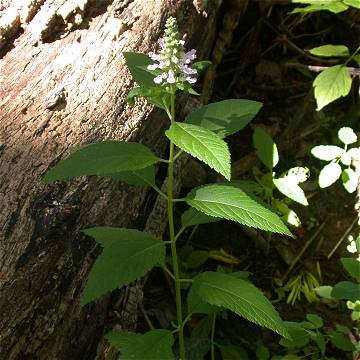

Teucrium canadense - (image 1 of 6)
Taxonomy
Family: Lamiaceae
Habitat
Moist open habitats. Shaded floodplains. Roadside and other disturbed habitats.
Associates
Distribution
Most of the U.S. and southern Canada.
Morphology
Rhizomatous perennial to 1 m. Stems pubescent, solitary. Leaves opposite, lance-ovate to oblong, 5-12 cm, simple, toothed, rounded at the base, petiolate. Flowers crowded in a terminal, spiciform, 5-20 cm long raceme; bracts slender, to 1 cm; pedicels 1-3 mm; calyx 5-8 mm, campanulate, 10-nerved, 2 lipped, with 5 teeth, the 3 upper lobes wider and more blunt than the lower 2; corolla pink-purple, 11-18 mm, cleft to the summit of the calyx, seemingly 1-lipped, the upper lip with two small lobed and seeming to arise from the lateral margins of the well developed, declined, and 3 lobed lower lip, the central lobe much larger; stamens 4, exserted and arching over the corolla; ovary 4-lobed, the style terminal, with the nutlets laterally attached and almost completely united.
Notes
Flowers early July to early September
Wetland indicator: Facultative Wetland
Leaves give off an unpleasant scent when bruised.
References
Gleason, Henry A. and A. Cronquist. 1991. Manual of Vascular Plants of Northeastern United States and Adjacent Canada. Second Ed.
The New York Botanical Garden. Bronx, NY
Swink, F. and G. Wilhelm. 1994. Plants of the Chicago Region.
Indiana Academy of Science. The Morton Arboretum. Lisle, Illinois.
|
Michael Hough © 2005 |